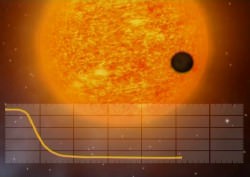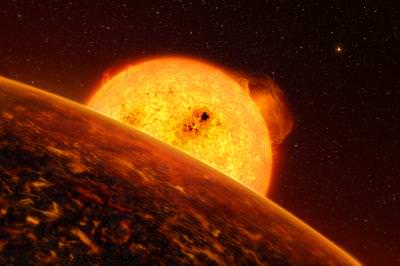[/caption]
If any creature lives on COROT-7b, the recently confirmed rocky exoplanet, they might think the sky is falling. This planet is close enough to its star that its “day-face” is hot enough to melt rock, and according to models by scientists at Washington University in St. Louis, COROT-7b’s atmosphere is made up of the ingredients of rocks and when “a front moves in,” pebbles condense out of the air and rain into lakes of molten lava below. Yikes!
This unusual rocky world was the first planet found orbiting the star COROT-7, an orange dwarf in the constellation Monoceros, or the Unicorn. COROT-7b is less than twice the size of Earth and only five times its mass. But this place is nothing like Earth.
“The only atmosphere this object has is produced from vapor arising from hot molten silicates in a lava lake or lava ocean,” said Bruce Fegley Jr., Ph.D., professor at Wash U, who created models of COROT-7b along with research assistant Laura Schaefer. Their paper appears in the Oct. 1 issue of The Astrophysical Journal.
This star-facing side has a temperature of about 2600 degrees Kelvin (4220 degrees Fahrenheit). That’s infernally hot—hot enough to vaporize rocks. The global average temperature of Earth’s surface, in contrast, is only about 288 degrees Kelvin (59 degrees Fahrenheit).
The side in perpetual shadow, on the other hand, is positively chilly at 50 degrees Kelvin (-369 degrees Fahrenheit).

So, what might the planet’s atmosphere be like? To find out Schaefer and Fegley used thermochemical equilibrium calculations with a special computer program called MAGMA that was used to study high-temperature volcanism on Io, Jupiter’s innermost Galilean satellite.
Because the scientists didn’t know the exact composition of the planet, they ran the program with four different starting compositions. “We got essentially the same result in all four cases,” says Fegley.
Perhaps because they were cooked off, COROT-7b’s atmosphere has none of the volatile elements or compounds that make up Earth’s atmosphere, such as water, nitrogen and carbon dioxide.
“Sodium, potassium, silicon monoxide and then oxygen — either atomic or molecular oxygen — make up most of the atmosphere.” But there are also smaller amounts of the other elements found in silicate rock, such as magnesium, aluminum, calcium and iron.
Why is there oxygen on a dead planet, when it didn’t show up in Earth’s atmosphere until 2.4 billion years ago, when plants started to produce it?
“Oxygen is the most abundant element in rock,” says Fegley, “so when you vaporize rock what you end up doing is producing a lot of oxygen.”
The peculiar atmosphere has its own singular weather. “As you go higher the atmosphere gets cooler and eventually you get saturated with different types of ‘rock’ the way you get saturated with water in the atmosphere of Earth,” explains Fegley. “But instead of a water cloud forming and then raining water droplets, you get a ‘rock cloud’ forming and it starts raining out little pebbles of different types of rock.”
Even more strangely, the kind of rock condensing out of the cloud depends on the altitude. The atmosphere works the same way as fractionating columns, the tall knobby columns that make petrochemical plants recognizable from afar. In a fractionating column, crude oil is boiled and its components condense out on a series of trays, with the heaviest one (with the highest boiling point) sulking at the bottom, and the lightest (and most volatile) rising to the top.
Instead of condensing out hydrocarbons such as asphalt, petroleum jelly, kerosene and gasoline, the exoplanet’s atmosphere condenses out minerals such as enstatite, corundum, spinel, and wollastonite. In both cases the fractions fall out in order of boiling point.
The atmosphere of COROT-7b may not be breathable, but it is certainly amusing.
Source: Washington University


So if I want to ever visit the planet, I’ll want to bring an extra-heavy-duty umbrella? =P
If the day side is so hot and the night side cold, then wouldn’t the vaporized rock be gradually transported to the dark side?
@Nexus – not necessarily, the cool half would be pulled towards the center due to shift of mass little by little, and would melt again.
I would like to say – for any and all future space corporations, this planet is a ‘gold mine.’
Does this planet has global atmospheric patterns? or is it very localised??
An interesting and entertaining model and conjecture. So, that’s why bits of hail are called hail “stones”.
btw, unlike Fahrenheit or Celsius, the Kelvin is not supposed to be a “degree”…
So future civilizations may not only terraform planets but “hellaform” them for production purposes.
Absolutely!
http://www.ljplus.ru/img4/f/u/fulbert/corot7b.png
An artist’s conception of what the human exploration of COROT-7b might look like.
Fulbert: I laughed. Out loud. =D
Bwahahahahahaha! That’s brilliant, Fulbert.
Fulbert: I think that would make an awesome Astro-Art (or is it Photoshoptica Galactica?) entry! You should consider submitting that as an entry!
Ack! I meant Battlestar Photoshoptica! Sorry, too many beers and games of chess tonight (I blame the chess).
Nexus, You raise of course an interesting question. I would imagine that what atmosphere this planet has, vaporized rock essentially, does get precipitated out closer to the dark side of the planet. This would be mostly along an annulus where the stellar radiation is about tangent to the planetary surface. This probably is similar to tectonic spreading in the mid-atlantic rift. I might suppose solid rock builds up and increases mass and stress on the region of deposition. This then plastically deforms the rock which might then get moved into the stellar facing ocean of molten rock to be remelted and vaporized.
This planet soiunds perfectly lovely, if you are maybe a certain type of silicon life form. The universe dishes up a wide diversity of planetary forms and “landscapes.” So far virtually all of them are utterly lethal to us.
LC
@LBC: This planet sounds like a paradise for the Horta of “The Devil in the Dark” fame: http://en.wikipedia.org/wiki/Horta_%28Star_Trek%29 🙂
That is one of the more seminal Star Trek episodes. I remember coming home in the 8th grade and turning on ST reruns. I had just learned about the periodic table and through that episode I was aware of carbon and silcon in the same column and have analogous out shells of electrons. Watching this was a bit of a horizon expanding moment. Star Trek did do that in some cases.
Of course this planet is not that bad. I have been working on string dualities and quantum field entanglements between the event horizon and the quantized singularity. Now there is a serious environment: closed strings are distended into open strings, graviton modes tranformed into tachyon condensates and … . Makjes the interior of a neutron star look positively mild. So the surface environment of COROT is really very nice compared to what else is out there,
But one does have this though, it’s a rocky planet and more of them should be friendlier than this.
LC
@LBC: Glad to see that you found inspiration from “The Devil in the Dark” episode of Star Trek. I saw it when it was originally aired (March 9, 1967). Even though I was only 9 years old at the time, this episode introduced me to the notion of inorganic life and only sharpened my interest in astronomy. As mentioned on the above linked Wiki page “William Shatner writes in his memoirs that “The Devil in the Dark” was his favorite original Star Trek episode. From Shatner’s perspective, this episode was “exciting, thought-provoking and intelligent, it contained all of the ingredients that made up our very best Star Treks”. Well put.
As you point out, a day spent on COROT-7b is a walk in the park compared to the inner accretion disk and event horizon of a black hole that you now study.
Too cool.
The unpleasant climate of this planet at least is composed of matter in a more or less ordinary state. That might be compared to a neutron star, which is a gas of neutrons about 10^14 times the density and pressure of ordinary matter. The surface is composed of iron in a degenerate electron state, 10^{12} times the density of Earth, with 10^{13}Gauss magnetic field which may distend this dense crust into stalagmites. Then of course there are black holes, where I think the singularity is a quantum state in a duality with holographic states on the horizon, and where this duality involves the deformation of the very laws of physics we currently understand.
Of course the surface of an ordinary star, and even more its interior, are horrendous environments in of themselves. Our local planets are pretty inhospitable, but at least we can put probes around them, and plant a few on some surfaces —, Luna, Mars, Titan and Venus (very briefly). And of course 12 humans have been on the moon, though for short durations.
LC
I have a semi-sloped garden and am using Lava Rock as a mulch. I find it helps with erosion issues as well. Are there any negatives to using Lava Rock as a mulch? The only reason I ask, is everyone thinks I’m crazy when I let them know what I’m using. Also, is there a difference in the black and red, other than their color? Thanks for any help!
I have a semi-sloped garden and am using Lava Rock as a mulch. I find it helps with erosion issues as well. Are there any negatives to using Lava Rock as a mulch? The only reason I ask, is everyone thinks I’m crazy when I let them know what I’m using. Also, is there a difference in the black and red, other than their color? Thanks for any help!